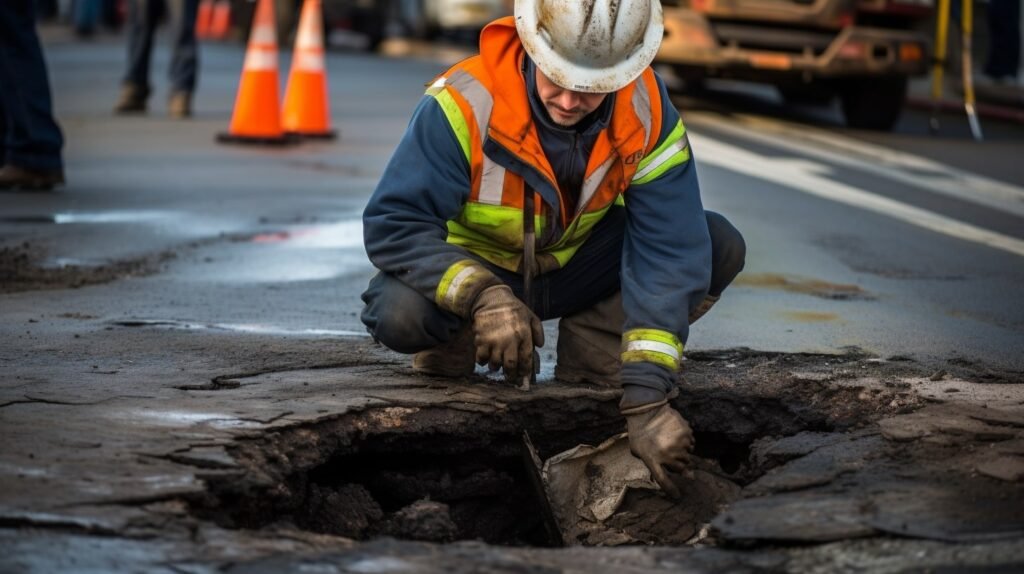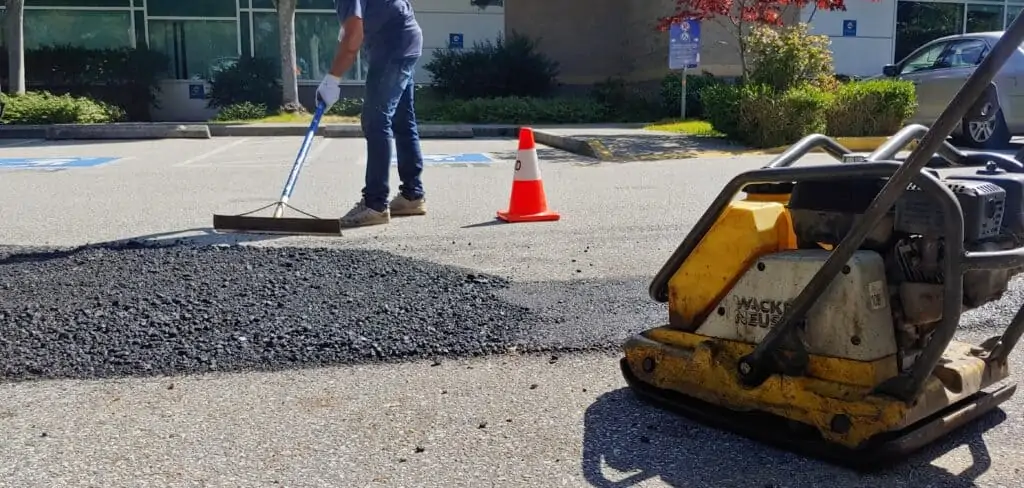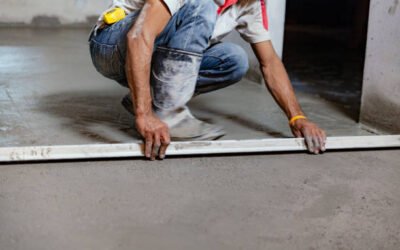Potholes are more than just a nuisance; they are a nemesis to drivers and a detriment to vehicle health. But beyond the tire damage and the collective groan from motorists, potholes pose a significant risk to road safety and municipal budgets. The journey to restore the tarmacs begins with understanding and selecting the right repair techniques. As communities worldwide seek efficient road maintenance solutions, exploring the plethora of repair methods becomes a crucial endeavour. This guide will navigate through the intricacies of various pothole repair techniques, weigh their pros and cons, and unearth cost-effective ways to sustain road integrity for the long haul.
Table of Contents
Introduction to Pothole Repairs
Understanding the Impact of Potholes on Roads
The perils of potholes stretch far beyond the surface. They start inconspicuously as small cracks but eventually grow into gaping wounds, thanks to the relentless cycle of freezing and thawing. Accelerated by the weight of traffic and the cruelty of weather, these road deformities can lead to increased vehicle repair costs, compromised driver safety, and the disruption of daily commutes.
Did you know? A study by the Canadian Automobile Association (CAA) found that potholes cause approximately $3 billion in vehicle repairs annually across Canada, underlining their economic impact.
The Importance of Timely and Efficient Repairs
When it comes to potholes, procrastination is an enemy; timely intervention can prevent the transformation of minor road damage into more significant and cost-intensive repairs. Efficient repair techniques not only restore the road surface but also curtail the ripple effects of potholes on a community’s well-being and its economy.
Key takeaway: Addressing potholes promptly and effectively is vital for ensuring road safety, reducing vehicle damage, and maintaining smooth transportation.
Assessing the Pothole Situation
How to Evaluate the Severity of a Pothole
A careful examination of a pothole informs the appropriate repair technique. Factors that play into the severity assessment include the pothole’s depth and width, its position in the road, and the volume of traffic affected. Safety of the motorists and potential for property damage also weigh in on how urgent the repair is.
To gauge the severity, municipalities may use a rating system, classifying potholes into different priority levels for repair teams to tackle. This systematic approach ensures that the most hazardous potholes receive attention first, mitigating the risks they pose to the public.
Did you know? Some cities use advanced technologies, such as machine learning and drones, to identify and classify pothole severity, streamlining the maintenance process and response times.
Factors Influencing Pothole Repair Method Selection
The choice of repair method is influenced by numerous factors, including but not limited to, weather conditions, the available resources such as labour and materials, budget constraints, and expected longevity of the repair. Municipalities must also consider environmental implications, balancing the immediate need for road safety with sustainable practices.
Key takeaway: Selecting the right pothole repair method requires a comprehensive assessment of severity, resources, and affecting factors to achieve a lasting solution.
Traditional Pothole Repair Techniques
Cold Patching: Pros, Cons, and Procedure
Cold patching is a traditional and widely used method for fixing potholes. It involves filling the pothole with premixed asphalt material, which can be applied at ambient temperatures. For its ease of use, it is often a go-to for quick repairs, especially in colder climates where hot asphalt would cool too quickly.
While cold patching is user-friendly and suitable for immediate repairs, it is often considered a temporary fix. Over time, the material may loosen, requiring additional treatment. Still, for emergency fixes, especially in lower-traffic areas or during inclement weather, it reigns as an accessible solution.
Did you know? Cold patch asphalt can be stored and used throughout the year, making it a versatile option for municipalities.
How to Make Pothole Repairs with QUIKRETE®
Hot Mix Asphalt Patching: When and How to Use It
Compared to its cold counterpart, hot mix asphalt patching involves applying hot asphalt to the pothole. It requires specific equipment to heat the material and is typically a more durable repair option. This method is ideal for high-traffic areas where long-term solutions are essential.
The primary challenge with hot mix asphalt lies in its need for appropriate temperatures, making it less viable in colder climates. Nonetheless, it promises a more seamless integration with the existing pavement and is less likely to fail when skillfully applied by professionals.
Key takeaway: For long-term durability and strength, hot mix asphalt patching is a superior traditional method, albeit one that is heavily reliant on proper weather conditions and professional application.
Modern Pothole Repair Methods
Infrared Asphalt Repair Technology
Infrared asphalt repair is a modern solution that uses infrared rays to heat the damaged area, allowing for seamless integration of new and old asphalt. This technology is effective for not only pothole repairs but also for fixing asphalt irregularities, such as seams and joints.
One of the advantages of infrared technology is its ability to recycle the existing asphalt, making it a more environmentally friendly option. Additionally, it requires less new material and provides a stronger bond, reducing the likelihood of a pothole reappearing at the same spot.
Did you know? Infrared repair has the ability to extend the life of existing pavement by many years, essentially rejuvenating the asphalt.
Spray Injection Patching for Quick Fixes
Spray injection patching is a method that involves blasting a pothole clean of debris with air, then injecting it with asphalt emulsion, and finally covering it with a layer of aggregate. This repair can be performed in various weather conditions and is known for its rapid curing time.
Though highly effective for immediate repairs, spray injection patching’s longevity can vary and may depend on the machine’s calibration and the operator’s technique. It is particularly suitable for municipalities looking to quickly address a large number of potholes with minimal disruption to traffic.
Key takeaway: Modern techniques like infrared asphalt repair and spray injection patching offer innovative solutions to pothole repairs that can be both cost-effective and environmentally sustainable.
Patching Techniques Comparison
| Patching Technique | Description | Application Temperature | Setting Time | Durability | Cost | Suitable for Weather Conditions | Material Used | Required Equipment | Best Used For |
|---|---|---|---|---|---|---|---|---|---|
| Cold Patching | Asphalt mix that can be applied at ambient temperatures. | Any temperature | Immediate use after application | Temporary to Semi-permanent | Low | All weather conditions | Cold Asphalt Mix | Shovel, Tamper | Small potholes, Emergency repairs |
| Hot Mix Asphalt Patching | Hot asphalt mix that requires heating before application. | Warm conditions | Requires time to cool and harden | Long-term | High | Not suitable for cold weather | Hot Asphalt Mix | Heating equipment, Roller/Compactor | High-traffic areas, Major roads |
| Infrared Asphalt Repair | Uses infrared technology to heat existing asphalt, then mixes with new asphalt. | Any temperature | Immediate use after cooling | Long-term | Medium to High | All weather conditions | Existing and New Asphalt Mix | Infrared Heater, Rake, Roller | Seamless repairs, Larger areas, Leveling surfaces |
| Spray Injection Patching | Cleans pothole with air, then sprays asphalt emulsion followed by aggregate. | Any temperature | Immediate use after application | Temporary to Semi-permanent | Medium | All weather conditions | Asphalt Emulsion, Aggregate | Spray Injection Equipment | Quick fixes, Utilities cuts, Wide-spread road defects |
Cost-Effectiveness of Each Repair Technique
Long-Term vs. Short-Term Cost Analysis
When assessing the cost-effectiveness of pothole repair techniques, it’s important to consider both short and long-term costs. Short-term costs may favour traditional cold patching due to its low initial investment and ease of application. However, frequent reapplication can inflate long-term costs, significantly reducing its cost-effectiveness.
In contrast, methods such as hot mix asphalt and infrared repairs, while initially more expensive due to equipment and material costs, may prove more economical over time with their longer-lasting results. Evaluating the full life-cycle cost of repairs is essential for municipalities to make informed decisions.
Did you know? Long-term cost savings from durable repair methods can free up municipal budgets for other essential services.
Return on Investment for Each Method
Beyond the upfront costs, return on investment (ROI) is a pivotal measure of a repair method’s true value. Generally, modern methods like infrared repairs boast a higher ROI as they restore the integrity of the asphalt for a longer period, leading to fewer repairs and reduced maintenance costs.
However, the context of each repair scenario may shift the scales. High-traffic areas and regions susceptible to extreme weather conditions may require a more robust solution, such as the use of modern methods, to achieve a satisfactory ROI.
Key takeaway: Considering both initial costs and long-term ROI ensures a balanced approach in selecting the most cost-effective pothole repair method for specific situations.
Cost Comparison Between Repair Methods
| Repair Method | Average Cost per Square Foot | Initial Material Costs | Labor Costs | Equipment Costs | Longevity of Repair | Total Estimated Cost Over 5 Years |
|---|---|---|---|---|---|---|
| Cold Patching | $1.50 – $2.50 | Low | Low | Minimal/None | 6 months – 1 year | $3.00 – $5.00 |
| Hot Mix Asphalt Patching | $2.00 – $4.00 | Medium | Medium | High | 2 – 5 years | $2.00 – $4.00 |
| Infrared Asphalt Repair | $3.00 – $5.00 | Medium | Medium | Medium | 5+ years | $3.00 – $5.00 |
| Spray Injection Patching | $1.75 – $3.25 | Low | Low | Medium | 1 – 3 years | $3.50 – $6.50 |
Evaluating Repair Durability and Sustainability
Factors Affecting the Durability of Repairs
Durability of pothole repairs is influenced by a multitude of factors including, but not limited to, the repair method, quality of materials, application process, and prevailing weather conditions. The structural integrity of the surrounding pavement also plays a role, as does the volume and weight of traffic over the repair.
Proper compaction and seamless bonding with the surrounding pavement are critical to the longevity of any repair. In this regard, modern methods with more sophisticated procedures can often provide a more resilient restoration.
Did you know? The proper preparation of the pothole, such as cleaning and drying before the application of repair materials, is crucial for durability.
Environmental Considerations in Pothole Repairs
Sustainability is becoming an increasingly important consideration in road maintenance. With the construction industry contributing to significant carbon emissions, methods that utilize recycled materials or reduce the need for new asphalt are desirable.
Infrared asphalt technology, for example, promotes the reuse of existing asphalt, reducing waste and demand for new materials. Similarly, cold-in-place recycling is a method where the old asphalt is milled, mixed with new binders, and then replaced on the road, all of which contribute to a more ecologically responsible approach.
Key takeaway: Environmental sustainability should be a core consideration in evaluating pothole repair methods, with modern techniques often offering greener solutions.
DIY Pothole Repair: Is It a Viable Option?
Required Tools and Materials
For the ambitious homeowner or local community group, DIY pothole repair can be a cost-saving venture. The basic necessities include cold patch asphalt, a tamper or compactor, and protective gear. Ensuring you have these tools, along with clear instructions and safety precautions, is the first step to tackling the task at hand.
However, the feasibility of DIY pothole repair depends largely on the size and depth of the pothole, as well as the repairer’s technical skill. Large or complex repairs often benefit from the expertise and equipment of professionals.
Did you know? Many hardware stores offer pothole repair kits that include everything you need for small-scale repairs, making DIY more accessible.
Step-by-Step Guide for Homeowners
Successfully repairing a pothole on your own involves several steps:
- cleaning out debris from the pothole,
- filling it with repair material,
- properly compacting the fill, and
- sealing it to prevent moisture ingress.
Following these steps diligently is crucial for a repair that lasts beyond just a few days.
While online tutorials and guides can be helpful, it’s important to approach DIY repairs with realistic expectations. Some potholes, especially those resulting from structural road issues, may be beyond the scope of DIY methods and require professional assessment.
Key takeaway: While DIY pothole repair can be an economical option for smaller issues, ensuring the correct approach and recognizing the limits of personal skillsets are essential.
Professional Repair Services: What to Look For
Certifications and Qualifications Necessary
When the limits of DIY are reached, professional services come into play. These experts not only have access to high-quality materials and equipment but also the necessary training to execute durable repairs. Certification from recognized authorities and a solid track record are indicators of a capable service provider.
Verify the qualifications of any potential contractor, including their adherence to local regulations and standards. A reputable company should willingly provide references and demonstrate their experience with similar repairs.
Questions to Ask Before Hiring a Professional
Before committing to a service, there are essential questions to ask: What warranty do they offer on their repairs? What is their timeline for completion? How do they ensure safety during repairs? Their answers will offer insight into their work ethic and dedication to quality.
Sourcing multiple quotes and asking for detailed breakdowns can help you understand the cost drivers and ensure you’re getting value for your money.
Key takeaway: Selecting a professional repair service requires due diligence in reviewing their qualifications, methodology, and commitment to quality and safety.
Hiring a Professional Checklist:
| Checklist Item | Description | Completed (Yes/No) |
|---|---|---|
| Verify Licenses and Certifications | Ensure the service provider is properly licensed and certified to perform road repairs in your jurisdiction. | √ |
| Check for Insurance | Confirm that the contractor has liability insurance to cover any accidents or damages during the repair process. | √ |
| Ask for References and Past Work Examples | Request a list of previous clients or projects to assess the quality and success of the contractor’s past work. | √ |
| Compare Multiple Quotes | Get detailed quotes from several service providers to compare prices and services included. | √ |
| Review Warranty and Guarantee Policies | Understand what warranties or guarantees are provided with their service for future repair or maintenance work. | √ |
| Inquire About Timelines | Discuss when the work can be started and the expected duration of the repairs. | √ |
| Understand Post-Repair Service | Clarify whether post-repair inspections are included and if there are additional charges for follow-up services. | √ |
| Analyze the Contract Thoroughly | Ensure that all aspects of the job are clearly outlined in the contract, including scope, cost, and any contingencies. | √ |
| Assess the Repair Method Proposed | Consider if the repair method suggested is suitable for the nature and severity of the potholes. | √ |
| Question Safety Measures | Discuss what safety measures will be put in place during the repair process to ensure the safety of the workers and the public. | √ |
City Wide offers asphalt & blacktop repair in Metro Vancouver.
Innovative Techniques and Future of Pothole Repairs
The Role of Smart Materials in Pothole Repairs
The surge in ‘smart’ materials heralds a promising future for pothole repairs. These materials can adapt to environmental changes or bear self-healing properties, reducing the frequency of roadworks. Smart asphalt, for instance, can respond to temperature fluctuations, self-healing cracks before they evolve into potholes.
Did you know? Some smart materials can change their density in reaction to pressure, which might significantly extend the lifespan of repaired patches.
Research and Emerging Technologies
Innovation doesn’t stop at smart materials. Research into conductive concrete and asphalt laced with nanotechnology sheds light on roads that can de-ice themselves or charge electric vehicles as they drive. Moreover, automation and robotics are set to revolutionize the way we approach pothole repairs, potentially allowing for 24/7, highly efficient maintenance operations.
Key takeaway: Innovation in materials and technology is crucial for sustainable, long-lived pothole repairs, with emerging technologies ready to redefine maintenance strategies.
Conclusion
Recap of Pothole Repair Techniques and Methods
Potholes, a significant concern for roadway maintenance, have been confronted with varying repair techniques. We’ve examined traditional methods like cold and hot patching, alongside modern innovations like infrared repairs and spray injection. Each carries distinct advantages and limitations regarding cost, durability, and environmental impact.
Final Thoughts on Making an Informed Decision
Ultimately, the choice of pothole repair method will hinge on a nuanced balance of these factors. Decision-makers must weigh immediate constraints against long-term benefits, local environmental dynamics, and the overarching goals of the community.
A holistic approach, considering both current and future repair needs, will guide the selection of the most appropriate pothole repair method for durable and sustainable roadways.
FAQs
What is the most cost-effective repair method for large-scale pothole problems?
For extensive pothole issues, methods that offer longevity like hot mix asphalt, or those that blend cost-efficiency with durability, such as infrared repair, often emerge as the most cost-effective solutions.
Can pothole repairs be environmentally friendly?
Yes, especially with techniques that utilize recycled materials, like cold-in-place asphalt recycling or the use of smart, self-healing materials, minimizing waste and the need for new raw materials.
How often should repaired potholes be reevaluated for safety?
Repaired potholes should be regularly inspected at least annually, or more frequently depending on traffic volume and environmental conditions, to ensure ongoing safety and repair integrity.
What are the legal implications of improper pothole repairs?
Improper repairs can lead to road hazards, potentially resulting in accidents and liability for municipalities. Ensuring compliance with industry standards is vital to forestall legal repercussions.
Are there any grants or government support for repairing potholes in my community?
Yes, in Canada, provincial and federal funding programs are sometimes available for road maintenance, including pothole repairs. Communities should inquire with local government bodies about available grants or subsidies.










